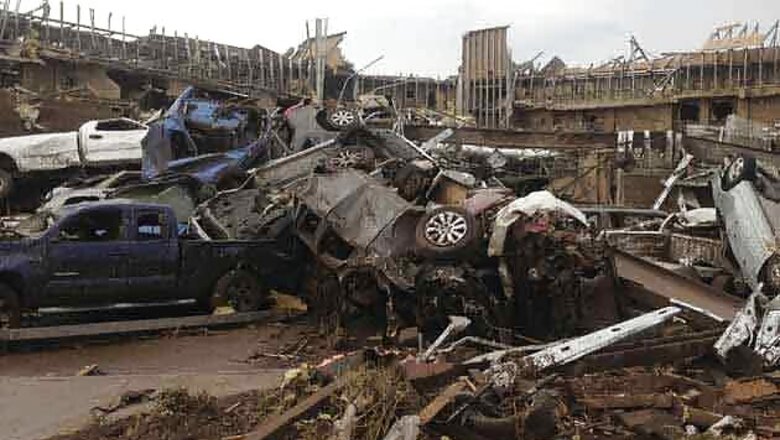
views
Moore (Oklahoma): A massive tornado tore through the Oklahoma City suburb of Moore on Monday, killing at least 51 people with winds of up to 200 miles per hour (320 kph) that flattened entire tracts of homes, two schools and a hospital, leaving a wake of tangled wreckage.
Rescue workers raced against the setting sun to find survivors in Oklahoma as the dangerous storm system threatened as many as 10 US states with more twisters. The Oklahoma medical examiner confirmed 51 deaths, making it the deadliest US tornado since one killed 161 people in Joplin, Missouri, two years ago, according to the National Weather Service. There were 70 reported deaths in all of 2012.
Some 20 to 30 school children were missing and feared dead beneath the rubble, KFOR television reported, citing unnamed officials from the scene.
Police and fire crews pulled third-graders from the devastated Plaza Towers Elementary school in Moore, a KFOR television reporter said from the scene, and aerial video showed teams sifting through the rubble left behind.
"I have never seen anything like this in my 18 years covering tornadoes here in Oklahoma City. This is without question the most horrific," said Lance West, a reporter for KFOR.
The National Weather Service Storm Prediction Center provided the town with a warning 16 minutes before the tornado touched down at 3:01 p.m. local time (2001 GMT), which is greater than the average eight to 10 minutes of warning, said Keli Pirtle, a spokeswoman for the center in Norman, Oklahoma.
The notice was upgraded to emergency warning with "heightened language" at 2:56 pm, or five minutes before the tornado touched down, Pirtle said.
Television images showed blocks of homes leveled by the powerful tornado, cars piled atop one another and buildings on fire.
The National Weather Service assigned the twister a preliminary ranking of EF4 on the Enhanced Fujita Scale, meaning the second most powerful category of tornado with winds up to 200 mph (320 kph).
Briarwood Elementary School, which also stood in the storm's path, was all but destroyed. On the first floor, sections of walls had been peeled away, affording clear views into the building, while in other areas, cars hurled by the storm winds were lodged in the walls.
While the school was a wreck, nearby playground equipment stood undamaged, though littered with rubble.
Across the street, people picked through the remains of their homes, looking for any possessions they might salvage.
At least 45 people were injured, according to officials of four hospitals. "They (injured) are coming in minute by minute," said Integris Southwest Medical Center spokeswoman Brooke Cayot. Of the 19 injured there, seven were in critical condition, seven serious and five listed as fair or good, Cayot said.
The University of Oklahoma Medical Center had received at least 20 injured. St Anthony Healthplex South in Oklahoma City said it received four patients and Midwest Regional received four.
Moore Medical Center sustained significant damage. "The whole city looks like a debris field," Glenn Lewis, the mayor of Moore, told NBC.
"It looks like we have lost our hospital. I drove by there a while ago and it's pretty much destroyed," Lewis said.
Fire, rescue and emergency medical teams from across the state converged on Moore, and members of the National Guard, activated by Governor Mary Fallin, were on the scene, said Terri Watkins, a spokeswoman for the Oklahoma Department of Emergency Management.
"They are going to going to go house to house, building to building to determine whether anyone is trapped," Watkins said. "If anyone is trapped we want to begin pulling them out as quickly as possible."
The massive twister struck at the height of tornado season, and more were forecast. On Sunday, tornadoes killed two people and injured 39 in Oklahoma.
Witnesses said Monday's tornado appeared more fierce than the giant twister that was among the dozens that tore up the region on May 3, 1999, killing more than 40 people and destroying thousands of homes. That tornado ranked as an EF5, meaning it had winds over 200 mph (320 kph).
The 1999 event ranks as the third-costliest tornado in US history, having caused more than $1 billion in damage at the time, or more than $1.3 billion in today's dollars. Only the devastating Joplin and Tuscaloosa tornadoes in 2011 were more costly.
The National Weather Service predicted a 10 per cent chance of tornadoes in parts of Texas, Oklahoma, Arkansas, Kansas, Missouri and Illinois. It said parts of four other states - Wisconsin, Indiana, Michigan and Iowa - have a 5 percent risk of tornadoes. The area at greatest risk includes Joplin, which on Wednesday will mark two years since the tornado that killed 161 people.




















Comments
0 comment